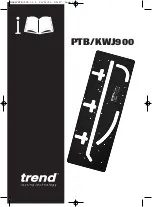
KT5500 5-
1
/
2
” T
ong
& CLInCHER® B
aCKup
S
ECTIon
C
onTEnTS
3.28
T
ECHnICaL
M
anuaL
M
aInTEnanCE
M. TUBULAR CONNECTION EQUIPMENT DE-COMMISSIONING PROCEDURE
Perform the following decommissioning procedures when removing tubular connection equipment from service, with the intent of
short to long-term storage. These procedures are essential for ensuring proper protection of the equipment from environmental attack,
and to aid in the quick turnaround when returning the equipment to service.
Store all o-rings, seals, packings, gaskets, etc. in strong moisture proof, airtight containers. Ensure that these items are not crushed,
nicked, or otherwise damaged.
Do not perform any further actions or maintenance while the tong is connected to any hydraulic power supply. Farr recommends
that all hydraulic lines are fully disconnected, and residual hydraulic pressure is bled off. Ensure adequate containment is in place to
prevent environmental contamination from residual hydraulic fluid.
D
epressurizAtion
p
roceDure
i
n
p
repArAtion
f
or
s
torAge
:
1) Rotate the tong so that the opening in the rotary gear faces the gear train (towards the rear of the tong). Ensure tong and
backup doors (if equipped) are closed. Fully extend the lift cylinder (if equipped). If mounted in a frame, retract the float cylin-
ders (if equipped).
2) De-energize the power unit.
3) Repeatedly actuate the tong motor control valve lever IN BOTH DIRECTIONS to dissipate any residual pressure in the valve
and motor.
4) Remove the hydraulic SUPPLY line from the equipment.
5) Repeatedly actuate the remaining control valve levers IN BOTH DIRECTIONS to dissipate any residual pressure in the
remainder of the hydraulic control system.
7) Disconnect the hydraulic RETURN line from the equipment.
8) Disconnect remaining hoses such as case drains, or lines connected to the turns counter.
1.
Perform an initial wash of the tool in order to remove the majority of dirt and grease build-up. Ensure adequate contain-
ment is in place to prevent environmental contamination from residual hydraulic fluid and dirty grease.
2.
Remove the access panel on the side of the tong directly adjacent to the shifter mechanism.
3.
Clean the interior of the tong thoroughly, using either water (do not use a pressure washer), or an appropriate solvent-
based grease-cutting cleaner such as Varsol. Ensure adequate containment is in place to prevent environmental con-
tamination from residual hydraulic fluid, dirty grease, and cleaning agents. Make a note if any metal shavings or metal
pieces are flushed out of the gear train cavity - if shavings or metal pieces are seen the tong must be overhauled before
it is returned to service.
4.
Clean the exterior of the tool thoroughly, using either water (do not use a pressure washer), or an appropriate solvent-
based grease-cutting cleaner such as Varsol. Ensure adequate containment is in place to prevent environmental contami-
nation from residual hydraulic fluid, dirty grease, and cleaning agents.
5.
Inspect all fasteners and fastener safety wires. Replace any missing fasteners - use Grade 8 bolts only. Re-torque all
external fasteners to SAE specifications.
6.
Inspect backing pin(s). If cracked, broken, or bent it (they) must be replaced.
7.
Repair or replace any damaged or missing external body parts, such as torque gauge mounts, hydraulic supports, safety
door protectors, etc.
8.
Inspect all paint - locations in which the paint has been damaged must be repaired prior to storage. Prepare areas to be
painted to ensure they are free of grease, dirt, or solvent. Touch up using a solvent-based acrylic paint - “McCoy Grey” is
paint number RAL7015. Allow sufficient time for paint to dry before proceeding.
9.
Perform a liberal lubrication of the equipment - refer to Maintenance section of manual to determine lubrication points.
Generously fill the gear train housing with grease through the access panel, and also through the opening in the rotary
gear.
10.
Connect the equipment to a hydraulic power unit. Ensure all lines are fully made up to prevent equipment damage from
excessive back pressure. Do not neglect to connect the motor drain.
11.
Energize power unit.
12.
Rotate tong for one minute, stop, and reverse the direction of rotation for another minute, ending with the opening of the
rotary gear facing the gear train. De-energize the power unit, and perform another generous lubrication of the gear train,
including the gear housing.
HYDRAULIC PRESSURES AS HIGH AS OPERATING PRESSURE MAY REMAIN TRAPPED IN
SMALL AREAS OF THE EQUIPMENT. ENSURE ALL MAINTENANCE IS CARRIED OUT BY A
QUALIFIED SERVICE TECHNICIAN, AND THAT ADEQUATE PERSONAL PROTECTIVE EQUIP-
MENT IS USED TO GUARD AGAINST PRESSURE-INDUCED INJURIES
Summary of Contents for 80-0420-16
Page 2: ......
Page 4: ...This page intentionally left blank ...
Page 6: ...This page intentionally left blank ...
Page 10: ...This page intentionally left blank ...
Page 34: ...This page intentionally left blank ...
Page 120: ...This page intentionally left blank ...
Page 128: ...This page intentionally left blank ...















































